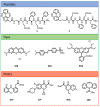A Peptide-Based Hydrogel for Adsorption of Dyes and Pharmaceuticals in Water Remediation
- PMID: 36286173
- PMCID: PMC9601570
- DOI: 10.3390/gels8100672
A Peptide-Based Hydrogel for Adsorption of Dyes and Pharmaceuticals in Water Remediation
Abstract
The removal of dyes and pharmaceuticals from water has become a major issue in recent years due to the shortage of freshwater resources. The adsorption of these pollutants through nontoxic, easy-to-make, and environmentally friendly adsorbents has become a popular topic. In this work, a tetrapeptide-pyrene conjugate was rationally designed to form hydrogels under controlled acidic conditions. The hydrogels were thoroughly characterized, and their performance in the adsorption of various dyes and pharmaceuticals from water was investigated. The supramolecular hydrogel efficiently adsorbed methylene blue (MB) and diclofenac (DCF) from water. The effect of concentration in the adsorption efficiency was studied, and results indicated that while the adsorption of MB is governed by the availability of adsorption sites, in the case of DCF, concentration is the driving force of the process. In the case of MB, the nature of the dye-hydrogel interactions and the mechanism of the adsorption process were investigated through UV-Vis absorption spectroscopy. The studies proved how this dye is first adsorbed as a monomer, probably through electrostatic interactions; successively, at increasing concentrations as the electrostatic adsorption sites are depleted, dimerization on the hydrogel surface occurs.
Keywords: diclofenac; dye adsorption; hydrogel; methylene blue; peptide; pharmaceuticals adsorption; supramolecular gel; water remediation.
Conflict of interest statement
The authors declare no conflict of interest.
Figures






References
-
- Glassmeyer S.T., Hinchey E.K., Boehme S.E., Daughton C.G., Ruhoy I.S., Conerly O., Daniels R.L., Lauer L., McCarthy M., Nettesheim T.G., et al. Disposal practices for unwanted residential medications in the United States. Environ. Int. 2009;35:566–572. doi: 10.1016/j.envint.2008.10.007. - DOI - PubMed
-
- Dolar D., Ignjatić Zokić T., Košutić K., Ašperger D., Mutavdžić Pavlović D. RO/NF membrane treatment of veterinary pharmaceutical wastewater: Comparison of results obtained on a laboratory and a pilot scale. Environ. Sci. Pollut. Res. 2012;19:1033–1042. doi: 10.1007/s11356-012-0782-7. - DOI - PubMed
Grants and funding
LinkOut - more resources
Full Text Sources
Miscellaneous

